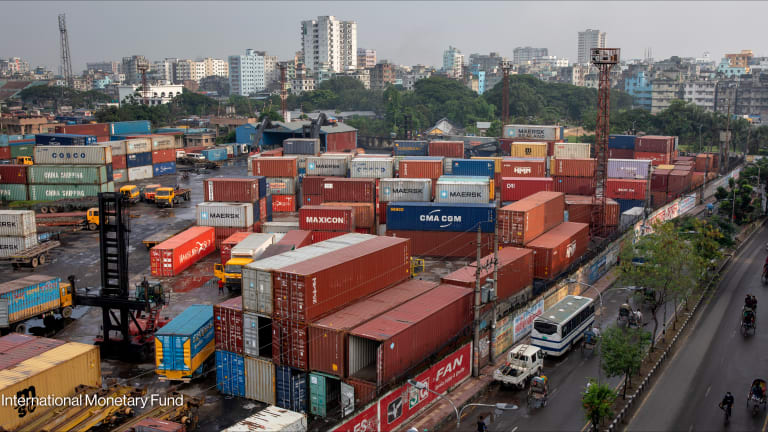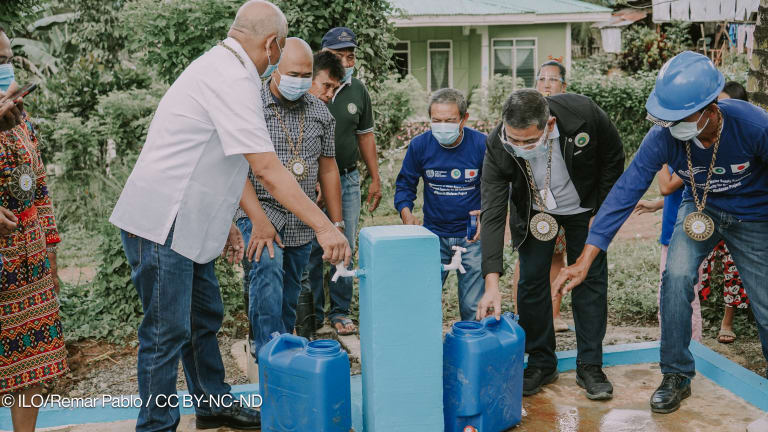What do strategies from 2019 tell us about donors' priorities?
Devex Analytics assesses data from 205 country strategies spanning over 100 locations from 25 donors. This appraisal for 2019 highlights the specific locations of strategies, top donors, and which sectors receive the most strategies.
Donors release strategic documents that detail their objectives and are usually country-based, while others are sector-focused. These strategies provide a roadmap with a specific time frame, location, and objectives and aim to inform development professionals — including policymakers, implementers, and other funders — about planned commitments. Country strategy plans provide an early look into the specifics of donor investing in the upcoming years. But this information is often dispersed across a variety of sources in a decentralized manner. Devex Analytics has aggregated the strategic documents and strategies starting in 2019 and 2020 to provide a better understanding of what these plans entail. The analysis assesses data from 205 country strategies spanning over 100 locations from 25 donors, all of which can be readily found on the Devex Funding Platform. Scope of strategies Out of 112 countries, four regions, and worldwide strategies, the country with the highest number of individual strategies for 2019 and 2020 was Bhutan. As a rapidly growing low-middle-income country scheduled to graduate from least-developed country status in 2023, Bhutan has shown promising progress, with poverty rates dropping from 23.2% to 8.2% in little over a decade. On average, the strategies for Bhutan last about three years with half being published by United Nations agencies: United Nations Development Programme, World Food Programme, and UNICEF. The U.N. strategy for Bhutan with the highest commitment, funded by UNICEF, aims to improve child survival, development, and protection; education; and social policy. This strategy, for four years, is valued at nearly $28 million. Out of all strategies published, 13 do not target a particular country or region and are worldwide in scope. These strategies focus on a specific development sector rather than focusing on priorities in a given country. For these, the two largest sectors are trade and policy — with three strategies — and environment and natural resources — with two strategies. The top three donors with the most worldwide strategies are the French Development Agency with three, followed by the Swedish International Development Cooperation Agency and the U.K. Department for International Development with two each. More than half of the worldwide strategies have a duration of three years, however, DFID’s strategies last one year and a strategy published by the UN Refugee Agency will continue until 2030. The worldwide strategy with the most funding was published by the World Trade Organization with the aim to improve the economic situation of the LDCs through two main goals: create a more inclusive trade environment and increase international trade and exports for the LDCs. This strategy has a value of $150 million with a duration of three years. Foremost funders Out of the 25 donors that published strategies for 2019 and 2020, the top three were the U.N., the U.S. Centers for Disease Control and Prevention, and the Asian Development Bank. The U.N. published 54 strategies beginning in 2019 and 2020, which constitute about 26% of the total number of released strategies. These are scattered over 39 different countries and regions with most for Bhutan and Angola at three strategies each. The two largest sectors behind the U.N.'s strategies are agriculture and rural development, and humanitarian aid. Out of all U.N. strategies, 43 are implemented by WFP with a focus on food and nutrition security. These cover 36 countries and regions and mainly focus on providing better access to a nutritious diet and food assistance in the case of crises. Overall, WFP assists 86 million people and delivers 15 billion rations per year. Beyond WFP, other prominent implementing U.N. agencies include UNICEF, UNDP, UNHCR, and UN-Habitat. The second donor after the U.N. in terms of published strategies is CDC, comprising approximately 19% of the total strategies published in 2019 and 2020. The large number of strategies can be attributed to a relatively brief duration of the strategies — one year each. Out of all CDC strategies, 32 are implemented by the U.S. President's Emergency Plan for AIDS Relief, five by the U.S. Department of State, and one by the U.S. Agency for International Development. PEPFAR works with CDC in order to improve HIV/AIDS epidemic control in almost 40 countries. As the top organization in the HIV/AIDS response, it has invested over $85 billion globally since 2003 and retains strong bipartisan support. Since 2018, PEPFAR has been aiming to direct over 70% of its funding towards indigenous and local organizations as opposed to larger international organizations. In a recent interview with Devex, U.S. Global AIDS Coordinator Ambassador Deborah Birx stated her confidence that PEPFAR will be able to reach this ambitious goal — many organizations are currently at over 40% and some are at 90% of the localization targets. The donor with the third-highest number of published strategies, after the U.N. and CDC, is ADB. They published 20 strategies, which equates to 10% of the total strategies. Only three of the 20 strategies last four years — the remaining ones last for two years only. ADB strategies are implemented in 17 countries and economic development is the largest sector with seven strategies, followed by infrastructure with five strategies. Within the sector of economic development, one four-year strategy focuses on private sector-led growth and social development for Fiji. With a total value of $600 million, it has three objectives: to promote private-sector-led growth, improve access to quality public and social services, and increase resilience to disasters through regional cooperation and integration. Sectors of investment All 205 strategies cover a range of 19 development sectors. Overall, the top three sectors are agriculture and rural development with 45 strategies, economic development with 37 strategies, and global health with 37 strategies. The agriculture and rural development sector spans 38 countries and regions with the top locations; Côte d'Ivoire, Liberia, Sudan, Burkina Faso, Malawi, Cape Verde, and Cuba, all with two strategies each. The U.N., primarily through WFP, is by far the top donor for this sector, with 23 strategies published, followed by the International Fund for Agricultural Development, a U.N. specialized agency that is not included in the U.N. umbrella, with 12. All of the U.N. agriculture and rural development strategies address food security and nutrition with the aim to improve overall nutrition standards and increase food resilience in the face of a crisis. Many of these strategies have a specific focus on nutrition for vulnerable groups including women and children. One of these strategies in Tajikistan has a value of over $82 million. The World Bank is the top donor within the economic development sector with 10 out of 37 strategies, which the World Bank refers to as country partnership frameworks. On average, these last just under four years. Historically, the World Bank has tended to direct its funding toward infrastructure and energy projects. However, in the strategies published for 2019 and 2020, we can see an overall shift toward human capital based projects in line with a broader human capital project by the bank. For example, one strategy based in Georgia, valued at $709 million, has the two main objectives of investing in human capital and building resilience. Other prominent donors in the economic development sector include other multilateral banks like ADB and the Inter-American Development Bank. The top four countries for economic development across the different donors are Laos, Cambodia, Armenia, and Paraguay — each with two strategies. Devex Funding Platform All of this information can be found on the Devex Funding Platform, which currently features over 1,500 country strategies from over 40 donor sources. These strategies provide early, up-to-date insights for organizations and development professionals about the available funding and where it is going. Devex provides easy-to-use search functions and graphs that enable the user access to this daunting number of information-heavy documents. Maja Wisenberger, senior development analyst, supervised and contributed to this article. Devex Analytics is a team of analysts and data scientists, delivering actionable solutions on development issues through structured datasets, official reports, press releases, and community-sourced information. Do you have questions about our methodology or analysis? Reach out to our experts at analysts@devex.com.
Donors release strategic documents that detail their objectives and are usually country-based, while others are sector-focused. These strategies provide a roadmap with a specific time frame, location, and objectives and aim to inform development professionals — including policymakers, implementers, and other funders — about planned commitments. Country strategy plans provide an early look into the specifics of donor investing in the upcoming years. But this information is often dispersed across a variety of sources in a decentralized manner.
Devex Analytics has aggregated the strategic documents and strategies starting in 2019 and 2020 to provide a better understanding of what these plans entail. The analysis assesses data from 205 country strategies spanning over 100 locations from 25 donors, all of which can be readily found on the Devex Funding Platform.
Out of 112 countries, four regions, and worldwide strategies, the country with the highest number of individual strategies for 2019 and 2020 was Bhutan.
This story is forDevex Promembers
Unlock this story now with a 15-day free trial of Devex Pro.
With a Devex Pro subscription you'll get access to deeper analysis and exclusive insights from our reporters and analysts.
Start my free trialRequest a group subscription Printing articles to share with others is a breach of our terms and conditions and copyright policy. Please use the sharing options on the left side of the article. Devex Pro members may share up to 10 articles per month using the Pro share tool ( ).
Emma Stibi works with the Devex Analytics team based in Copenhagen, where she assists in curation, analysis, and dissemination of development data. She is currently finishing her bachelor’s degree in development studies at Lund University and has also studied in the U.S. and Korea. Her interests include gender equality and disaster risk management.








